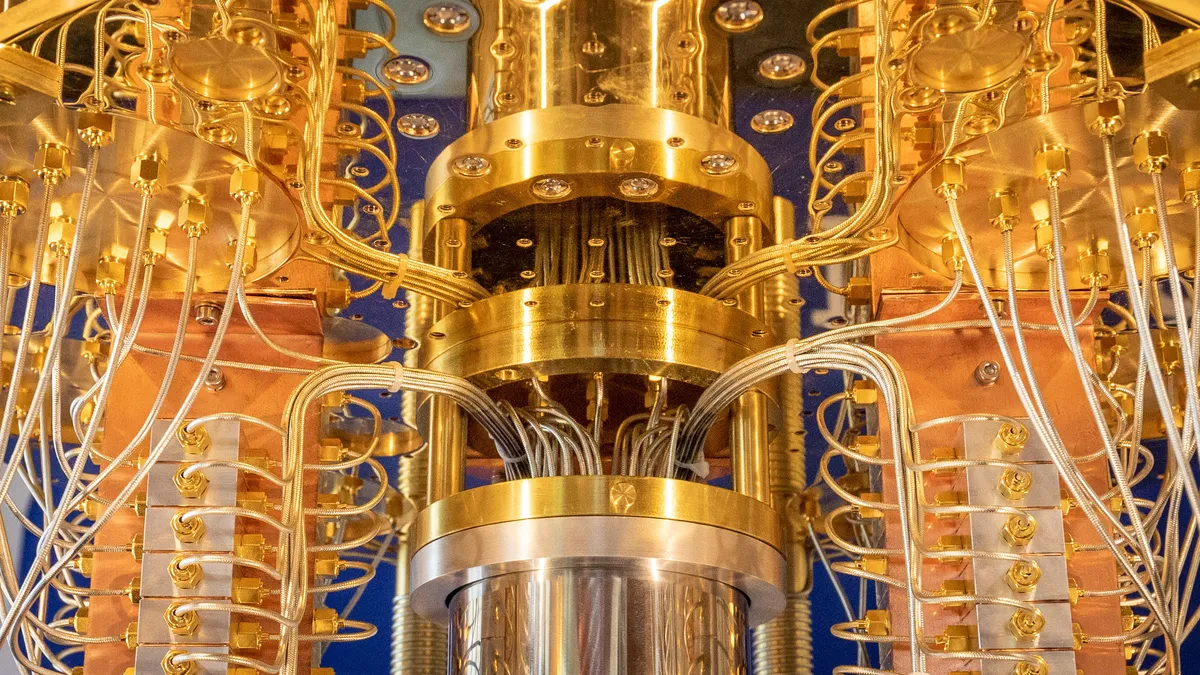New quantum computing architecture could be used to connect large-scale devices
Quantum computers hold the promise of performing certain tasks that are intractable even on the world’s most powerful supercomputers. In the future, scientists anticipate using quantum computing to emulate materials systems, simulate quantum chemistry, and optimize hard tasks, with impacts potentially spanning finance to pharmaceuticals.
量子计算机有望执行某些即使在世界上最强大的超级计算机上也难以处理的任务。在未来,科学家们预计将使用量子计算来模拟材料系统,模拟量子化学,并优化艰巨的任务,其影响可能涉及金融和制药业。
However, realizing this promise requires resilient and extensible hardware. One challenge in building a large-scale quantum computer is that researchers must find an effective way to interconnect quantum information nodes—smaller-scale processing nodes separated across a computer chip. Because quantum computers are fundamentally different from classical computers, conventional techniques used to communicate electronic information do not directly translate to quantum devices. However, one requirement is certain: Whether via a classical or a quantum interconnect, the carried information must be transmitted and received.
然而,实现这一承诺需要有弹性和可扩展的硬件。构建大规模量子计算机的一个挑战是,研究人员必须找到一种有效的方法来连接量子信息节点——分散在计算机芯片上的小规模处理节点。由于量子计算机与经典计算机有本质上的不同,用于通信电子信息的传统技术不能直接转化为量子设备。然而,有一个要求是肯定的:无论是通过经典互连还是量子互连,所携带的信息都必须被传输和接收。
To this end, MIT researchers have developed a quantum computing architecture that will enable extensible, high-fidelity communication between superconducting quantum processors. In work published in Nature Physics, MIT researchers demonstrate step one, the deterministic emission of single photons—information carriers—in a user-specified direction. Their method ensures quantum information flows in the correct direction more than 96 percent of the time.
为此,麻省理工学院的研究人员开发了一种量子计算架构,可以在超导量子处理器之间实现可扩展的高保真通信。在《自然物理》杂志上发表的研究成果中,麻省理工学院的研究人员演示了第一步,即单光子(信息载体)在用户指定的方向上的确定性发射。他们的方法确保了量子信息在96%以上的时间里朝着正确的方向流动。
Linking several of these modules enables a larger network of quantum processors that are interconnected with one another, no matter their physical separation on a computer chip.
将这些模块中的几个连接起来,就可以形成一个更大的量子处理器网络,无论它们在计算机芯片上的物理分离如何。
“Quantum interconnects are a crucial step toward modular implementations of larger-scale machines built from smaller individual components,” says Bharath Kannan Ph.D. ’22, co-lead author of a research paper describing this technique.
“量子互连是迈向由更小的单个组件构建的大规模机器模块化实现的关键一步,”22岁的Bharath Kannan博士说,他是描述该技术的一篇研究论文的联合主要作者。
“The ability to communicate between smaller subsystems will enable a modular architecture for quantum processors, and this may be a simpler way of scaling to larger system sizes compared to the brute-force approach of using a single large and complicated chip,” Kannan adds.
Kannan补充说:“在较小的子系统之间通信的能力将使量子处理器的模块化架构成为可能,与使用单个大型复杂芯片的暴力方法相比,这可能是一种更简单的扩展到更大系统尺寸的方法。”
Kannan wrote the paper with co-lead author Aziza Almanakly, an electrical engineering and computer science graduate student in the Engineering Quantum Systems group of the Research Laboratory of Electronics (RLE) at MIT. The senior author is William D. Oliver, a professor of electrical engineering and computer science and of physics, an MIT Lincoln Laboratory Fellow, director of the Center for Quantum Engineering, and associate director of RLE.
Kannan与Aziza Almanakly共同撰写了这篇论文,Aziza Almanakly是麻省理工学院电子研究实验室(RLE)工程量子系统组的电气工程和计算机科学研究生。资深作者是William D. Oliver,电气工程、计算机科学和物理学教授,麻省理工学院林肯实验室研究员,量子工程中心主任,RLE副主任。
Moving quantum information
移动量子信息
In a conventional classical computer, various components perform different functions, such as memory, computation, etc. Electronic information, encoded and stored as bits (which take the value of 1s or 0s), is shuttled between these components using interconnects, which are wires that move electrons around on a computer processor.
在传统的经典计算机中,不同的组件执行不同的功能,如内存、计算等。电子信息被编码并存储为比特(取值为1或0),通过互连在这些组件之间穿梭,互连是在计算机处理器上移动电子的电线。
But quantum information is more complex. Instead of only holding a value of 0 or 1, quantum information can also be both 0 and 1 simultaneously (a phenomenon known as superposition). Also, quantum information can be carried by particles of light, called photons. These added complexities make quantum information fragile, and it can’t be transported simply using conventional protocols.
但是量子信息更加复杂。量子信息不仅可以是0或1,还可以同时是0和1(这种现象被称为叠加)。此外,量子信息可以被称为光子的光粒子携带。这些增加的复杂性使得量子信息很脆弱,不能简单地使用传统协议进行传输。
A quantum network links processing nodes using photons that travel through special interconnects known as waveguides. A waveguide can either be unidirectional, and move a photon only to the left or to the right, or it can be bidirectional.
量子网络使用光子通过被称为波导的特殊互连连接处理节点。波导可以是单向的,只让光子向左或向右移动,也可以是双向的。
Most existing architectures use unidirectional waveguides, which are easier to implement since the direction in which photons travel is easily established. But since each waveguide only moves photons in one direction, more waveguides become necessary as the quantum network expands, which makes this approach difficult to scale. In addition, unidirectional waveguides usually incorporate additional components to enforce the directionality, which introduces communication errors.
大多数现有的架构使用单向波导,由于光子的运动方向很容易确定,因此更容易实现。但由于每个波导只向一个方向移动光子,随着量子网络的扩展,就需要更多的波导,这使得这种方法难以扩展。此外,单向波导通常包含额外的组件来加强方向性,这引入了通信错误。
“We can get rid of these lossy components if we have a waveguide that can support propagation in both the left and right directions, and a means to choose the direction at will. This ‘directional transmission’ is what we demonstrated, and it is the first step toward bidirectional communication with much higher fidelities,” says Kannan.
“如果我们有一种可以支持左右方向传播的波导,以及一种随意选择方向的方法,我们就可以摆脱这些有损组件。这种‘定向传输’就是我们所演示的,它是朝着具有更高保真度的双向通信迈出的第一步,”Kannan说。
Using their architecture, multiple processing modules can be strung along one waveguide. A remarkable feature the architecture design is that the same module can be used as both a transmitter and a receiver, he says. And photons can be sent and captured by any two modules along a common waveguide.
使用他们的架构,多个处理模块可以串在一个波导上。他说,该架构设计的一个显著特点是,同一个模块既可以用作发射机,也可以用作接收机。光子可以被任意两个模块沿同一波导发送和捕获。
“We have just one physical connection that can have any number of modules along the way. This is what makes it scalable. Having demonstrated directional photon emission from one module, we are now working on capturing that photon downstream at a second module,” Almanakly adds.
“我们只有一个物理连接,可以有任意数量的模块。这就是它可伸缩的地方。在演示了一个模块的定向光子发射后,我们现在正致力于在第二个模块中捕捉下游的光子,”Almanakly补充道。
Leveraging quantum properties
利用量子特性
To accomplish this, the researchers built a module comprising four qubits.
为了实现这一目标,研究人员构建了一个包含四个量子比特的模块。
Qubits are the building blocks of quantum computers, and are used to store and process quantum information. But qubits can also be used as photon emitters. Adding energy to a qubit causes the qubit to become excited, and then when it de-excites, the qubit will emit the energy in the form of a photon.
量子比特是量子计算机的组成部分,用于存储和处理量子信息。但量子比特也可以用作光子发射器。向量子位添加能量会使量子位变得兴奋,然后当它去兴奋时,量子位将以光子的形式释放能量。
However, simply connecting one qubit to a waveguide does not ensure directionality. A single qubit emits a photon, but whether it travels to the left or to the right is completely random. To circumvent this problem, the researchers utilize two qubits and a property known as quantum interference to ensure the emitted photon travels in the correct direction.
然而,简单地将一个量子比特连接到波导上并不能保证方向性。一个量子比特发射出一个光子,但它是向左还是向右移动完全是随机的。为了避免这个问题,研究人员利用两个量子比特和一种被称为量子干涉的特性来确保发射的光子沿正确的方向运动。
The technique involves preparing the two qubits in an entangled state of single excitation called a Bell state. This quantum-mechanical state comprises two aspects: the left qubit being excited and the right qubit being excited. Both aspects exist simultaneously, but which qubit is excited at a given time is unknown.
该技术涉及将两个量子位制备在称为贝尔态的单激发纠缠态中。这种量子力学状态包括两个方面:被激发的左量子比特和被激发的右量子比特。这两个方面同时存在,但在给定时间哪个量子比特被激发是未知的。
Read more at Phys.org
在Phys.org上阅读更多











